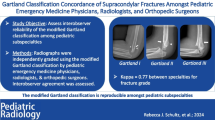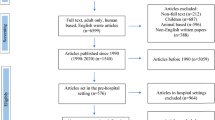Abstract
Purpose
To determine the impact of magnetic resonance imaging (MRI) on fracture classification for low lumbar fractures (LLFs) compared to CT alone.
Methods
This study was a retrospective review of 41 consecutive patients with LLFs who underwent CT and MRI within 10 days of injury. Three reviewers classified all fractures according to AOSpine Classification and the Thoracolumbar Injury Classification (TLISS). Posterior ligamentous complex (PLC) injury in MRI was defined by black stripe discontinuity and in CT by the presence of: vertebral body translation, facet joint malalignment, horizontal laminar or spinous process fracture, and interspinous widening. The proportion of patients with AO type A/B/C and with TLISS < 5 and ≥ 5 was compared between CT and MRI. We examined the overall accuracy and individual CT findings for PLC injury.
Results
AO classification using CT was: AO type A in 26 patients (61%), type B in 7 patients (17%), and type C in 8 patients (22%). Seventeen patients (41%) had a TLISS ≥ 5 while 24 (59%) had TLISS < 5. The addition of MRI after CT changed the AO classification in only 2 patients (4.9%, 95% CI (0.6–16.5%) due to upgrade of type A to type B or vice versa, but did not change TLISS from < 5 to ≥ 5 [p< 0.0001; 95% CI (0.59, 0.77)].
Conclusions
CT was highly accurate (95%) for diagnosis of PLC injury in LLFs. Addition of MRI after CT did not change the AO classification or TLISS, compared to CT alone, thus suggesting limited additional value of MRI for PLC assessment or fracture classification.




Similar content being viewed by others
Availability of data and material (data transparency)
‘Not applicable.' Code availability (software application or custom code): 'Not applicable.'
References
Seybold EA, Sweeney CA, Fredrickson BE et al (1999) Functional outcome of low lumbar burst fractures: A multicenter review of operative and nonoperative treatment of L3-L5. Spine (Phila Pa 1976) 24:2154–2161. https://doi.org/10.1097/00007632-199910150-00016
Reinhold M, Knop C, Beisse R et al (2010) Operative treatment of 733 patients with acute thoracolumbar spinal injuries: comprehensive results from the second, prospective, internet-based multicenter study of the Spine Study Group of the German Association of Trauma Surgery. Eur Spine J 19:1657–1676. https://doi.org/10.1007/s00586-010-1451-5
Schroeder GD, Kepler CK, Koerner JD et al (2015) Can a thoracolumbar injury severity score be uniformly applied from T1 to L5 or are modifications necessary? Glob Spine J 5:339–345. https://doi.org/10.1055/s-0035-1549035
Moore TA, Bransford RJ, France JC et al (2014) Low lumbar fractures: Does thoracolumbar injury classification and severity score work? Spine (Phila Pa 1976) 39:1021–1025. https://doi.org/10.1097/BRS.0000000000000415
Sansur CA, Shaffrey CI (2010) Diagnosis and management of low lumbar burst fractures. Semin Spine Surg 22:33–37. https://doi.org/10.1053/j.semss.2009.10.002
Lehman RA, Kang DG, Bellabarba C (2012) A new classification for complex lumbosacral injuries. Spine J 12:612–628. https://doi.org/10.1016/j.spinee.2012.01.009
Winklhofer S, Thekkumthala-Sommer M, Schmidt D et al (2013) Magnetic resonance imaging frequently changes classification of acute traumatic thoracolumbar spine injuries. Skeletal Radiol 42:779–786. https://doi.org/10.1007/s00256-012-1551-x
Pizones J, Izquierdo E, Álvarez P et al (2011) Impact of magnetic resonance imaging on decision making for thoracolumbar traumatic fracture diagnosis and treatment. Eur Spine J 20(Suppl 3):390–396. https://doi.org/10.1007/s00586-011-1913-4
Bossuyt PM, Irwig L, Craig J, Glasziou P (2006) Assessing new tests against existing diagnostic pathways. BMJ-332_1089-1092. 1089-1092
Whiting PF, Rutjes AWSS, Westwood ME et al (2011) QUADAS-2: a revised tool for quality assessment of diagnostic accuracy studies. Ann Intern Med 155:529–536
Haba H, Taneiciu H, Kotani Y et al (2003) Diagnostic accuracy of magnetic resonance imaging for detecting posterior ligamentous complex injury associated with thoracic and lumbar fractures. J Neurosurg 99:20–26. https://doi.org/10.3171/spi.2003.99.1.0020
Vaccaro AR, Oner C, Kepler CK et al (2013) AOSpine thoracolumbar spine injury classification system: Fracture description, neurological status, and key modifiers. Spine (Phila Pa 1976) 38:2028–2037. https://doi.org/10.1097/BRS.0b013e3182a8a381
Pizones Javier, Felisa Sánchez-Mariscal, Lorenzo Zúñiga, Patricia Álvarez EI (2013) Prospective analysis of magnetic resonance imaging accuracy in diagnosing traumatic injuries of the posterior ligamentous complex of the thoracolumbar spine. Spine (Phila Pa 1976) 38:745–51
Lee JY, Vaccaro AR, Schweitzer KM et al (2007) Assessment of injury to the thoracolumbar posterior ligamentous complex in the setting of normal-appearing plain radiography. Spine J 7:422–427. https://doi.org/10.1016/j.spinee.2006.07.014
Lee JY, Vaccaro AR, Lim MR et al (2005) Thoracolumbar injury classification and severity score: a new paradigm for the treatment of thoracolumbar spine trauma. J Orthop Sci 10:671–675. https://doi.org/10.1007/s00776-005-0956-y
Shinkins B, Thompson M, Mallett S, Perera R (2013) Diagnostic accuracy studies: how to report and analyse inconclusive test results. BMJ 346:1–11. https://doi.org/10.1136/bmj.f2778
Khurana B, Prevedello LM, Bono CM et al (2018) CT for thoracic and lumbar spine fractures: can CT findings accurately predict posterior ligament complex injury? Eur Spine J 27:3007–3015. https://doi.org/10.1007/s00586-018-5712-z
Aly MM (2021) Analysis of the combined CT findings improves the accuracy of CT for detecting posterior ligamentous complex injury of thoracolumbar spine as defined by MRI. World Neurosurg. Epub ahead of print 2021. https://doi.org/10.1016/j.wneu.2021.04.106.
Aly MM et al (2021) Diagnostic value of various morphological features of horizontal and vertical laminar fractures for posterior ligamentous complex injury of the thoracolumbar spine as defined by MRI. World Neurosurgery. https://doi.org/10.1016/j.wneu.2021.06.109
Jiang L, Zhang H, Chen H, Wu Q (2018) Kyphotic angle of the motion segment most accurately predicts injury to the ligamentous complex on computed Tomography Scan of thoracolumbar fractures. World Neurosurg 118:e405–e413. https://doi.org/10.1016/j.wneu.2018.06.202
McCormack T, Karaikovic E, Gaines RW (1994) The load sharing classification of spine fractures. Spine (Phila Pa 1976) 19:1741–1744
Farcy JPC, Weidenbaum M, Glassman SD (1990) Sagittal index in management of thoracolumbar burst fractures. Spine (Phila Pa. 1976) 15:958–965
Pizones J, Zúniga L, Sánchez-Mariscal F et al (2012) MRI study of post-traumatic incompetence of posterior ligamentous complex: importance of the supraspinous ligament. Prospective study of 74 traumatic fractures. Eur Spine J 21:2222–2231. https://doi.org/10.1007/s00586-012-2403-z
Rajasekaran S, Vaccaro AR, Kanna RM et al (2017) The value of CT and MRI in the classification and surgical decision-making among spine surgeons in thoracolumbar spinal injuries. Eur Spine J 26:1463–1469. https://doi.org/10.1007/s00586-016-4623-0
Jaeschke R, Guyatt GSD (1994) Users' guides to the medical literature diagnostic test. III How to use an artcle about a diagnostic test. B. What are the results and will they help me in caring for my patients? JAMA 271:703–707
Landis JR, Koch GG (1977) Landis amd Koch1977_agreement of categorical data. Biometrics 33:159–174. https://doi.org/10.2307/2529310
Van Middendorp JJ, Patel AA, Schuetz M, Joaquim AF (2013) The precision, accuracy and validity of detecting posterior ligamentous complex injuries of the thoracic and lumbar spine: a critical appraisal of the literature. Eur Spine J 22:461–474. https://doi.org/10.1007/s00586-012-2602-7
Dai LY (2002) Low lumbar spinal fractures: management options. Injury 33:579–582. https://doi.org/10.1016/S0020-1383(02)00021-9
Crosby CG, Even JL, Song Y et al (2011) Diagnostic abilities of magnetic resonance imaging in traumatic injury to the posterior ligamentous complex: The effect of years in training. Spine J 11:747–753. https://doi.org/10.1016/j.spinee.2011.07.005
Schmidt RL, Factor RE (2013) Understanding sources of bias in diagnostic accuracy studies. Arch Pathol Lab Med 137:558–565. https://doi.org/10.5858/arpa.2012-0198-RA
Qureshi S, Dhall SS, Anderson PA et al (2019) Congress of neurological surgeons systematic review and evidence-based guidelines on the evaluation and treatment of patients with thoracolumbar spine trauma: radiological evaluation. Clin Neurosurg 84:E28–E31. https://doi.org/10.1093/neuros/nyy373
Shaw CM, Flanagan F, Fenlon HM, McNicholas MM (2009) Consensus review of discordant findings maximizes cancer detection rate in double-reader screening mammography: Irish national breast screening program experience. Radiology 250:354–362. https://doi.org/10.1148/radiol.2502080224
Funding
No specific funding was received for this work.
Author information
Authors and Affiliations
Contributions
All authors contributed to the study conception and design. Material preparation, data collection and analysis were performed by MA, HE, AE, SA, and AA. The first draft of the manuscript was written by first author; all authors commented on previous versions of the manuscript. All authors read and approved the final manuscript.
Corresponding author
Ethics declarations
Conflict of interest
All authors declare they have no commercial associations that might pose a conflict of interest in relation to the manuscript.
Ethics approval
Local ethical committee approval was obtained for this study (IRB Registration number with KACST, KSA: H-01-R-012); informed consent was waived by the local ethics committee in view of the retrospective nature of the study, and all the procedures being performed were part of the routine care.
Additional information
Publisher's Note
Springer Nature remains neutral with regard to jurisdictional claims in published maps and institutional affiliations.
Rights and permissions
About this article
Cite this article
Aly, M.M., Al-Shoaibi, A.M., Abduraba, S. et al. Traumatic low lumbar fractures: How often MRI changes the fracture classification or clinical decision-making compared to CT alone?. Eur Spine J 31, 37–45 (2022). https://doi.org/10.1007/s00586-021-06987-x
Received:
Revised:
Accepted:
Published:
Issue Date:
DOI: https://doi.org/10.1007/s00586-021-06987-x




